Abstract
Model building in game sports should maintain the constitutive feature of this group of sports, the dynamic interaction process between the two parties. For single net/wall games relative phase is suggested to describe the positional interaction between the two players. 30 baseline rallies in tennis were examined and relative phase was calculated by Hilbert transform from the two time-series of lateral displacement and trajectory in the court respectively. Results showed that relative phase indicates some aspects of the tactical interaction in tennis. At a more abstract level the interaction between two teams in handball was studied by examining the relationship of the two scoring processes. Each process can be conceived as a random walk. Moving averages of the scoring probabilities indicate something like a momentary strength. A moving correlation (length = 20 ball possessions) describes the momentary relationship between the teams’ strength. Evidence was found that this correlation is heavily time-dependent, in almost every single game among the 40 examined ones we found phases with a significant positive as well as significant negative relationship. This underlines the importance of a dynamic view on the interaction in these games.
Key Points.
Game sports.
Mathematical modelling.
Relative phase.
Random walks.
Key words: Game sports, model-building, relative phase, random walks
Introduction
Game sports may be defined as those sports, where two parties (teams, doubles or single) try to achieve their goal and to avoid that the opponent achieves his one (Lames, 1991). This constitutes an interaction process, and the observable performance is rather the emergent result of this interaction process than the display of skills and abilities of the two parties. The nature of game sports also implies that this interaction process is dynamic. It changes during the match due to the permanent search for successful behaviour, due to strategic considerations depending for example on the actual score or due to a reaction imposed by an action of the opponent. This constitutes a sharp contrast to other sports such as 100m dash or marathon where performance is largely determined by the (rather constant) skills and abilities of the athletes.
If this notion of game sports as dynamic interaction processes is accepted, two important consequences are to be drawn. First, some of the traditional methods of performance analysis in sports science become doubtful. For example, the search for behavioural norms becomes a futile endeavour if behaviour changes dynamically and emerges from the singular encounter of the two opponents. Also, assessing individual skill in game sports will remain a problem as long as the measures used add up (weighted) frequencies of observed behaviour and do not respect the singularity and dynamics of an interaction process. The second consequence is that this notion stimulates the search for new models which are capable to describe the crucial properties of game sports, interaction and dynamics.
In this article, two approaches are outlined which tackle the challenges described above from different perspectives. First, the positional interaction between two players in single net and wall games is described by the relative phase between their trajectories. The second approach uses the random walk concept to assess the dynamical strength of the two teams in invasion games and studies the interaction between the two processes by moving correlations.
Relative Phase in Tennis
The idea of describing movements of two players with their relative phase was first introduced by McGarry et al., 1999 in squash. They were influenced by an interpretation of the players’ moves as the moves of a dancing couple. Certainly, another source of this idea was the successful application of relative phase in order to describe coordinative patterns in movement science (Haken et al., 1985; Kelso, 1995). McGarry et al., 1999 examined the absolute distance of the players from mid-court and found dominantly an anti-phase behaviour. Palut and Zanone, 2005 calculated relative phase for the first time with Hilbert transform. They used the lateral distance from mid-court in tennis and also found that most of the time, tennis players showed an anti-phase behaviour, but also in-phase values of relative phase showed a relative maximum.
Our own investigations were in tennis. We focused on methodological issues and addressed the question of the meaning of different values of relative phase for the status of the game.
Why is relative phase a promising approach to describe the spatial interactions in a net/wall game? From a systems point of view, the movements in tennis can be perceived as the movements of two subsystems, the players. These subsystems are strongly coupled by the nature of the game because they exchange strokes. While one player hits, the other tries to get in a “neutral ”position, from where he has the best opportunities to arrive in time at the next stroke. As soon as he recognizes the direction of the stroke, he moves to the place of contact, while the other player moves to his “neutral ”position. Figure 1 displays an idealised long-line and cross rally with the corresponding positions.
Figure 1.
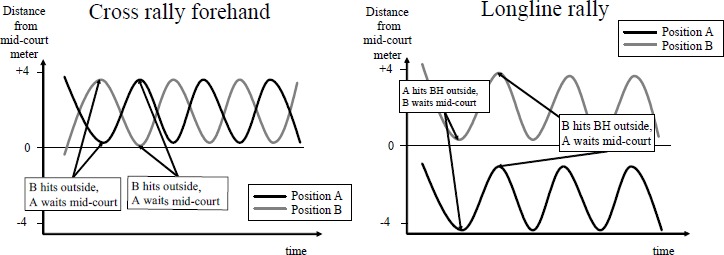
Idealised paths of lateral distance during a cross rally forehand and during a long-line rally in tennis. Relative Phase is constant in both cases, anti-phase (180°, left) and in-phase (0°, right).
A very interesting hypothesis from a practical point of view is the relation between the relative phase and the state of the rally. One might assume that a stable relative phase indicates a stable game when no player has problems to arrive just in time for his stroke. The very nature of tennis demands, though, to use placement and speed of the strokes to create pressure and win the point at last. This should result in a perturbation of relative phase. So, the hypothesis is that in a stable phase of the rally the relative phase is stable, but in the final phase, when a winner is scored or the opponent is forced to commit an error, the relative phase becomes unstable. If this hypothesis could be proven it would allow to determine the pressure created during a rally which would in turn be a valuable instrument for practical analyses.
We examined 30 rallies of top class athletes which we recorded from broadcasts of Grand Slam tournaments (Paris and Melbourne). The rallies were selected if they had a considerable length and if they were conducted and finished at the baseline. 18 rallies were played by female athletes. The positions of the players were obtained by image detection methods provided by the faculty of computer science, technical university Munich. Relative phase was calculated from the smoothed (1Hz filtering) time-series of positional data from the two players. The algorithm of Hilbert transform (MatLab) was used for the calculations. This procedure is well known in signal theory and allows to calculate continuous relative phase which is mandatory for we have comparatively few strokes in a rally (Pikovsky et al., 2001).
The first methodological issue we addressed was the optimal database for calculating relative phase. We found that the lateral displacements (see Figure 2) provide a good representation of the behaviour in the court, but have some weaknesses in their phase structure. This is due to the fact that even in baseline rallies the players move also perpendicular to the baseline in a considerable amount. As a result relative phase sometimes shows features that are hard to interpret when taking lateral displacements. The end of the rally is “announced ”by a change in relative phase from in-phase to anti-phase.
Figure 2.
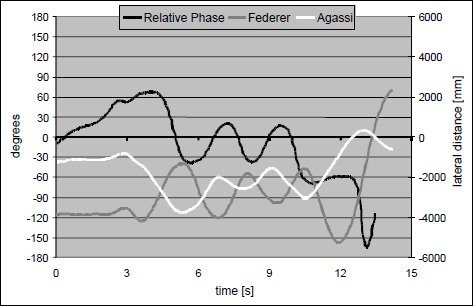
Lateral displacements and their relative phase of two male players.
As an alternative we took the players’ trajectory in the court from measurement to measurement (25 Hz). Actually these are speed data and relative phase now informs about the phase relation of moving speed of the players independent from their position on the court. With this data we usually get clear results for relative phase but we lack much of the understanding what is going on in the court (see Figure 3). As a result, we suggest analysing lateral displacement as well as the two-dimensional trajectories in the court.
Figure 3.
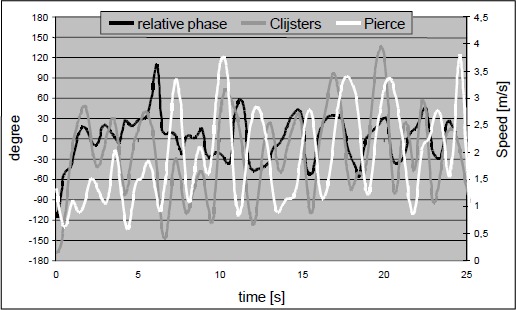
Speed of 2 female players during rally and relative phase between speed data.
The cyclical structure of the time series is evident, the rally ended with an unforced error o Clijsters which was not “announced ”in relative phase which fluctuates around in-phase throughout the rally.
Results concerning the distribution of relative phase show that taking speed data we obtain a one-peak distribution indicating the dominance of in-phase. This is due to the fact that the rally synchronises the players in the sense that they alternate between two states: low speed while one player hits and the other orients for his next stroke, high speed while one player approaches the ball for his next stroke and the other comes back from his stroke towards a neutral position. This is in good agreement with the findings of Palut and Zanone, 2005.
The dominant future task will be to link relative phase to tactical behaviour in the court. One way to achieve this will be a close examination of a larger sample of top-class rallies, but we will also instruct national-level tennis players to exhibit behaviour according to our instructions and study the provoked behaviour of relative phase.
Random Walk Modelling in Handball
The development of the score in handball for example may be perceived as two interlaced random walks. Each team has a probability p to score at ball possession, P(1)=p, and a probability of q=1-p not to score, P(0)=q. Figure 4 left shows these two random walks for one example, a game between Germany and Croatia at the world championships in 2001. It becomes obvious that the processes are dynamic, we have phases where almost each ball possession leads to a goal but we find also periods with no goal scored. In some phases the two teams perform at the same level, in other phases there are differences. The local performance may be described by moving averages of the score. In Figure 4 right the double backward moving average of length 4 is shown for each team. It reflects something like the momentary strength of a team and gives insight into the way the two teams interact.
Figure 4.
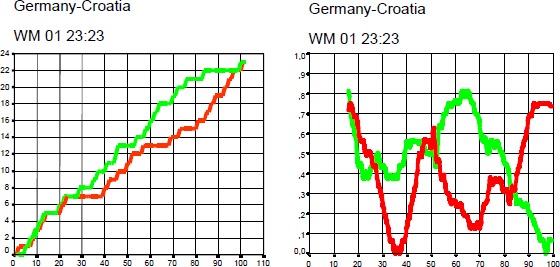
Left: development of score during a handball match. Right: Moving average of scoring probability.
There is evidence for the hypothesis that a team’s scoring rate is independent from the one of other team, but we see also phases with a seemingly strong dependence. Moreover, sometimes the momentary scoring probabilities seem to be negatively correlated (my team is good when the other is bad and vice versa, to be seen in the middle and the end of the example), but sometimes there is a positive relationship (my team performs well when the other does so, to be seen in the beginning).
This lead to the idea of calculating moving correlations in order to study the relationship between the two scoring processes. Figure 5 shows that there are phases with significant positive and negative correlations. This behaviour is typical for most of the 30 games examined so far.
Figure 5.
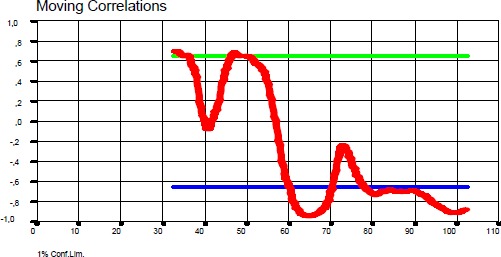
Moving correlations of length 20 between scoring probabilities in Figure 4 right.
Discussion
Modelling the positional interaction between tennis players by relative phase promises to reveal important insights into the nature of the game. Central aspects of game behaviour are described by relative phase. A certain limitation lies in the fact that relative phase is only apt to deal with longer rallies where the players try to create pressure by position play while scoring aces or unforced errors do not have an impact on relative phase. An interesting perspective is the description of other net/wall games by relative phase such as squash or badminton.
The examination of the scoring process as a random walk in handball provides theoretical as well as practical insights. For theorists it is fascinating to study the interaction dynamics during a game. For coaches it may be interesting to identify successful and less successful phases in a game as a starting point of a practical game analysis.
Conclusions
Modelling the interaction in game sports means a challenge to sports science so far. With the two models proposed here, some aspects of interaction may be analysed: the spatial interaction in net/wall games by relative phase and the scoring processes in team games by stochastic modelling.
Acknowledgement
I’d like to thank my student Florian Walter for the calculations of relative phase with matlab.
Biography

Martin LAMES
Employment
Professor for Movement and Training Science.
Degree
Prof. Dr
Research interests
Game sports theory, dynamic systems in sports.
E-mail: martin.lames@sport.uni-augsburg.de
References
- Haken H., Kelso J.A.S., Bunz H. (1985) A theoretical model of phase transitions in human hand movements. Biological Cybernetics 51, 347-356 [DOI] [PubMed] [Google Scholar]
- Kelso J.A.S. (1995) Dynamic patterns the self-organization of Brain and Behavior. Cambridge, Mass.: MIT-Press [Google Scholar]
- Lames M. (1991) Leistungsdiagnostik durch Computersimulation: Ein Beitrag zur Theorie der Sportspiele am Beispiel Tennis. Frankfurt, Thun: Harry Deutsch [Google Scholar]
- McGarry T., Anderson D.I., Wallace S.A., Hughes M.D., Franks I.M. (2002) Sport competition as a dynamical self-organizing system. Journal of Sport Sciences 20, 771-781 [DOI] [PubMed] [Google Scholar]
- McGarry T., Khan M.A., Franks I.M. (1999) On the presence and absence of behavioural traits in sport: an example from championship squash match-play. Journal of Sport Sciences 17, 297-311 [DOI] [PubMed] [Google Scholar]
- Pikovsky A., Rosenblum M., Kurths J. (2001) Synchronization: A universal concept in nonlinear sciences. Cambridge: University Press [Google Scholar]
- Palut Y., Zanone P.-S. (2005) A dynamical analysis of tennis players’ motion: Concepts and data. Journal of Sports Science 23, 1021-1032 [DOI] [PubMed] [Google Scholar]


